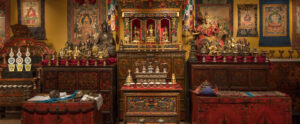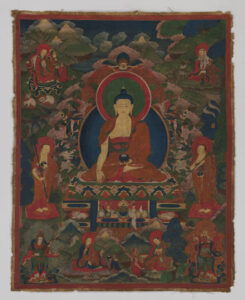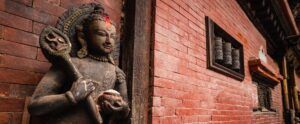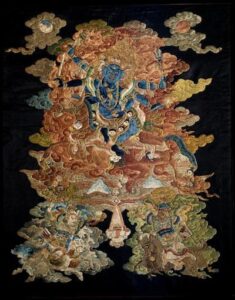Director Jorrit Britschgi has announced that the Rubin Museum will close its 17th Street galleries in New York in October 2024 to focus on its public outreach and collaborative partnerships with institutions worldwide.

Tibetan Buddhist Shrine Room, courtesy Rubin Museum of Art.
The late January announcement came as a shock to many in the art world. For the last twenty years, the Rubin has been a peaceful sanctuary for Himalayan art. The museum has fostered outstanding traditional scholarship of the ancient art and religions of the Himalayas as well as encouraging experimentation with new ways of teaching and learning about its distinctive cultures. The Rubin’s unique focus on the spiritual as well as the visual achievements of Buddhist and Hindu artists from the Himalayas made it a refuge from the hustle and bustle of Manhattan for the city’s public – as well as a place of pilgrimage for visitors from around the globe who came to see great Tibetan and Nepalese art.
The museum’s best-known exhibit, a complete Tibetan Buddhist shrine room will remain in New York at a new location. The shrine room is far more than a display of Tibetan art. In a step intended to facilitate meditation and concentration, the museum has made the experience of the shrine room accessible from anywhere in the world via a two hour long digital visual stream. The video is straightforward, simply a view of the room with its flickering lamps, but with an audio accompaniment of deeply resonant chanting by Buddhist monks of Maitri Vihar at Swayambhu in Kathmandu, Nepal, and nuns from the Tibetan Nuns Project, India.

Photographed September 2019
Although a small museum, the Rubin has organized extraordinary exhibitions. The 2019 exhibition, Faith and Empire-Art and Politics in Tibetan Buddhism, featured both exceptional artworks from the Rubin’s collection and loaned works from international museums and private collections. The exhibition utilized these works to highlight the dynamic political aspects of the Tibetan artistic tradition, particularly through Sino-Tibetan artistic exchange, from the 7th to the 19th century and featured an extensive catalog by senior curator Karl Debreczeny. It took visitors through Tibetan and Chinese history, demonstrating how successive dynasties embraced Tibetan Buddhism as a means of fulfilling the role of the Chakravartan ruler, a sacrosanct rulership exercising authority over the four continents.
Soon after, however, all New York’s museums were forced to by the outbreak of the Covid virus to close their doors and reopen gradually with limited attendance. The Rubin worked throughout to find alternative ways to bring its message to the broader public. The museum’s current plan is to advantage the work it began during the pandemic to continue reach a global audience through virtual and international exhibitions in cooperation with other museums and educational organizations. The museum has already had considerable success with its outside-of-the-box international programming, ranging from open access through digitization of its collections to educationally oriented initiatives such as its Project Himalayan Art, which combines the didactic with the beautiful in an online platform to serve teachers and students globally.
The Rubin also created the ongoing interactive Mandala Lab, which is currently open on the museum’s third floor. It had great success in its public installation in a park in Bilbao and has traveled as well to London. A multi-year campaign is underway to continue bringing access to the Mandala Lab to the global public.

Avalokiteshvara Padmapani, Swat region (present day Pakistan), ca. 9th century,
Brass, courtesy Rubin Museum of Art.
Other activities will continue through the Rubin’s Social, Emotional, and Ethical Learning® curriculum, in partnership with Emory University, which will serve schools and teachers in New York City and beyond. In this far-reaching program, “inspired by the philosophical traditions of Buddhism and Hinduism and aligned with ongoing research into learning, behavior, and the brain,” the Rubin’s programming will help students to “learn to self-reflect, identify emotions, be in the present moment, feel community, and practice compassion.”
The Rubin was also a lead supporter (with Nepal’s Ministry of Culture, its Academy of Fine Art and the Siddhartha Arts Foundation) in the establishment of Nepal’s first pavilion at the Venice Biennale, which featured the multimedia artworks of Tsherin Sherpa.
The vast majority of Tibetan artworks worldwide were brought out of Tibet after China’s brutal invasion and occupation, which resulted the destruction of over 95% of Tibetan monasteries and religious institutions. Without the preservation of Tibetan art and traditional culture in the Tibetan diaspora and in museums like the Rubin Museum around the world, there would be little hope of the preservation of Tibetan traditional culture in any form.
Recently, however, a few activists specializing in ‘art-crime’ who have little knowledge of Himalayan culture, and anonymous Nepalese bloggers have demanded the return of the museum’s artworks, including works made by Tibetan artisans and objects made by Newari artists for Tibetan monasteries.

Itumbaha Museum, Nepal, Photo courtesy Rubin Museum NYC.
The Rubin’s Director Jorrit Britschgi has been open about calls for repatriation of the museum’s collections, noting that the museum acquisition and research processes are geared to better understanding the works and their history, and that, “If there are other pieces that should be sent back, we will do that.” The Nepalese activists claims against the museum have not provided any evidence of wrongdoing by the museum. The museum has been very active in researching the provenance of objects in its collection and has returned three objects out of its collection of thousands of artworks in the last two years. The announcement of the museum’s closing states that its provenance research will continue while it is a ‘museum without walls.’ In fact, when an object in its collection was identified as having been taken from an ancient monastery in Kathmandu, the museum not only returned it but became a key sponsor for the creation of a museum at the Itumbaha monastery.’

Queen of the World, Sipai Gyelmo, China, 20th century, embroidery,
Courtesy Rubin Museum of Art.
In the early 1990s, local residents discovered over 500 ancient items in very bad condition in a storeroom in an important 11th-century monastery complex in the Kathmandu Valley. They established an organization, the Shree Bhaskardev Sanskarita Keshchandra Krit Paravat Mahavihar Conservation Society, to preserve the objects and developed a plan for an Itumbaha Museum to exhibit them, but eventually abandoned the plan because the government declined to fund it. After the 2015 earthquake, the locals contacted the Rubin Museum and asked for help. The museum provided both funding and expertise to enable the conservation and display of the monastery’s long neglected artifacts – enabling the opening of a museum at the monastery that the monastery had unsuccessfully begged the Nepalese government to support for decades. Throughout, the project was designed and developed by Nepalese, with support from the Rubin Museum and other foreign organizations.
The public still has time to see innovative exhibitions in the Rubin’s New York galleries. The exhibition Reimagine: Himalayan Art Now will open March 15th, will reach into virtually the entire museum, injecting site-specific contemporary artworks by more than 30 artists into and within the display of traditional artworks. The exhibition will include painting, sculpture, sound, video, installation, performance, and more. It is curated by Michelle Bennett Simorella, Director of Curatorial Administration & Collections at the Rubin Museum, with guest curators Roshan Mishra of Taragaon Next and Tsewang Lhamo of Yakpo Collective.
See also:
Courts, Politics, and Sino-Tibetan Artistic Exchange with Karl Debreczeny , Asian Art Museum. Rubin Museum of Art.
Symposium: Art, Politics, and Tibet’s Eastern Neighbors, Asia Society. Rubin Museum of Art.

Detail of Hevajra; China; Ming dynasty, Yongle period (1403-1424), ca. 1417–1423; silk embroidery; 51 3/5 x 32 in. (131 x 81 cm); Pritzker Collection; photograph by Hughes Dubois, Detail permission courtesy Rubin Museum of Art.
Kate Fitz Gibbon for The Committee for Cultural Policy and Global Heritage Alliance, Misuse of U.S. Heritage Law: State Department Seeks Blockade on Nepalese Art, Cultural Property News, September 17, 2023.
Kate Fitz Gibbon for The Committee for Cultural Policy and Global Heritage Alliance, SPECIAL REPORT: 2023 CHINA MOU – Building China’s Art Monopoly and Destroying Minority Culture and Identity, Cultural Property News, May 26, 2023.
Superb Rubin Museum Exhibition “Faith and Empire-Art and Politics in Tibetan Buddhism,” Cultural Property News, February 6, 2019.
 White Tara with Long Life Deities, Tibet
19th century, Rubin Museum of Art, Gift of the Shelley & Donald Rubin Foundation. Courtesy Rubin Museum of Art, NY.
White Tara with Long Life Deities, Tibet
19th century, Rubin Museum of Art, Gift of the Shelley & Donald Rubin Foundation. Courtesy Rubin Museum of Art, NY. 

